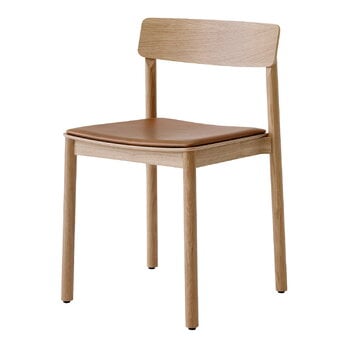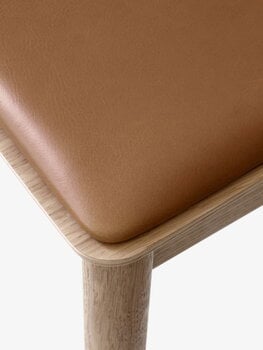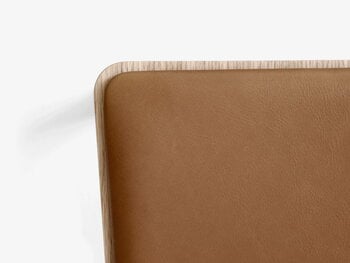Designed by Jakob Thau and Sami Kallio for &Tradition, Betty TK3 is a gorgeous solid wood chair with a leather-upholstered seat. The combination of a wooden surface and cognac aniline leather gives the chair an organic feel, which is accentuated by the beautiful patina that the natural leather will develop over time and use. The stable, lightweight structure makes the Betty chair perfect as a dining chair as well as a side chair in any room of the house.
Betty TK3 chair, oak - cognac Noble leather
&Tradition
Description
Designed by Jakob Thau and Sami Kallio for &Tradition, Betty TK3 is a gorgeous solid wood chair with a leather-upholstered seat. The combination of a wooden surface and cognac aniline leather gives the chair an organic feel, which is accentuated by the beautiful patina that the natural leather will develop over time and use. The stable, lightweight structure makes the Betty chair perfect as a dining chair as well as a side chair in any room of the house.
Product details (12)
- Colour
- Oak, brown
- Width
- 51 cm
- Depth
- 48 cm
- Height
- 78 cm
- Seat depth
- 42 cm
- Seat height
- 48 cm
- Frame material
- Lacquered solid wood and formpressed veneer
- Seat cushion
- HR foam
- Upholstery fabric
- Noble Aniline leather, cognac
- Weight
- 5.6 kg
- Stackable
- No
- Notes
- Wagner QuickClick felt gliders with interchangeable plastic inserts are installed as standard.
- Product ID
Reviews (0)
Sustainability
The Product Sustainability Framework, our criteria of sustainable design, helps you find the most sustainable products in our selection. Read below which sustainability criteria this product has met.
Working conditions & labour 8/9
-
Equal opportunities for all employees
-
Commitment to UN Global Compact, fair compensation for all employees
-
Corporate responsibility requirements defined and communicated for suppliers
-
Systematic work for improved inclusion and well-being in the workplace
-
Transparent supply chain
-
Suppliers' compliance to a code of conduct ensured
-
Direct suppliers audited and certified
-
Compliance to the UN Guiding Principles on Business and Human Rights ensured in the supply chain
-
Support for community involvement in the supply chain
Eco-friendly production 6/9
-
Fair and resource-wise water-use in production
-
No incineration or landfilling of returned items
-
No use of endangered species as materials
-
No direct environmental emissions or waste (excl. GHGs) from production
-
Material-efficient and ecological packaging
-
No potentially harmful chemicals used in own production
-
The sustainability of direct suppliers' production is addressed and monitored
-
Production and material sourcing that respect biodiversity, animal rights, and natural ecosystems
-
Positive impact on nature’s well-being through operations that regenerate natural ecosystems
Climate impact 5/8
-
Company's direct greenhouse gas emissions identified and commitment to reduction
-
Product's carbon impact identified and commitment to reduction
-
Guidance on energy- and eco-efficient use of the product
-
Contribution to climate initiatives beyond the brand’s direct operations
-
100 % renewable energy in own production and operations
-
Low-carbon or compensated transportation
-
Carbon footprint of the product calculated and goals set to reduce it
-
Carbon neutral or carbon negative product
Sustainable materials 5/6
-
Sustainable and long-lasting material choices
-
No harmful or hazardous substances
-
Responsible raw material sourcing and production
-
Materials suited for circularity: monomaterials, recyclable finishings, renewable or recycled contents etc.
-
Ecological materials: natural, biodegradable, recyclable or recycled contents
-
Outstanding materials in terms of innovativeness, responsibility, sustainability and circularity: local production or sourcing, 100 % recycled content, C2C-certification etc.
Circular design 4/5
-
High aesthetic quality promoting long-term use of the product
-
Technically durable product design and material choices
-
Design for enduring life-long quality
-
Design and support for product maintenance, repair and upgradability
-
Innovative circular design solutions: circular service system, resale platform, remanufacturing, collection of used products, etc.









